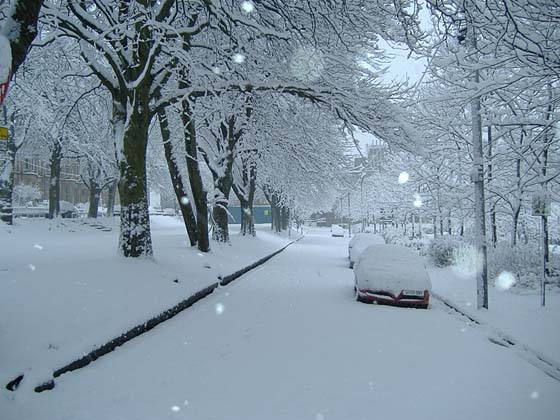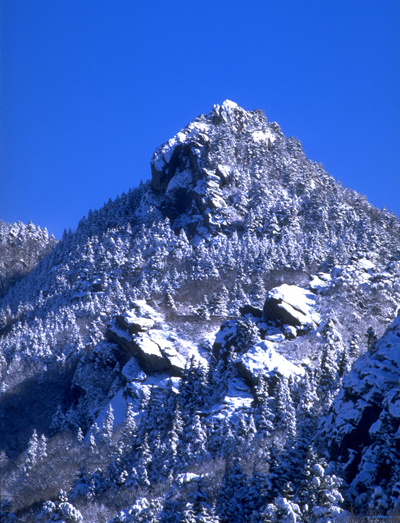Thoughts about Snow
February 15, 2011 by Somebody Else
Snow is great. We tend to think of it in terms of holiday season advertising, whether we choose to admit it or not. In our minds, we have these idealized images about snow, such as of a couple snuggled up before a warm fire, drinking hot cocoa, and roasting chestnuts while the snow comes down heavily; or of a bunch of happy, ruddy-cheeked folks piled into a big sleigh, singing Christmas carols at the top of their lungs while a team of magnificent and shiny horses pulls them through the deep snow; or of some traditional home -- with a great big, elaborately decorated Christmas tree in the front yard -- in some quaint town, everything glimmering and sparkling with lovely multi-colored Christmas lights and covered with a whole bunch of snow, just like white icing thickly spread on top of some perfectly executed holiday cake out of a magazine. Yeah, we say to ourselves with a nostalgic sigh, that's snow.
I don't know how the rest of the world feels about snow, but that pretty much describes how much of the United States of America feels about it.
However, there are indeed certain regions of the United States where snow is not idealized. Not surprisingly, those are regions that actually do receive regular amounts of real snow. The snowiest city in the lower forty-eight states is, I believe, Buffalo, New York, which receives so much snow during a typical winter that by the time spring rolls around, the stuff is piled up to the rooftops. New England as a whole is a pretty snowy region. Interestingly, if you take a trip to Florida in the winter months, which is something that I personally have done, you will find that half the cars there have New England license plates. Why are they down in Florida in the winter? Why is it that almost all of south Florida's retirement population is from New England? The answer is that they don't have romantic ideas about snow. They've been intimate with snow for a long time, and the thrill is gone, as the classic R&B tune goes. Maybe they want a "divorce" from snow, so that's why they've headed off to Florida.

The other extreme would be the southern United States, which loves snow probably more than any other region, most likely because in the South, a snowfall can be a transcendently rare occurrence. In a typical winter, most of the southern United States gets enough snow to meet the slushy junk drink needs of Los Angeles, California for five minutes on any given day in July. So, for southerners, a good snow is a kind of magical dream come true, the day that their southern city or town might be transformed into something magical. On that day they busy themselves by running off to the supermarket to empty the shelves of practically every edible item -- especially milk and white bread for some unknown reason. Then, when the snow really starts to come down, they head off in their cars to drive around and look at it, utterly amazed. Sadly, after one or two inches of snow has fallen, the sun comes out, and within twenty minutes or so the dusting of white powder has almost completely disappeared, but before that happens, the southerners have improvised sleds with cardboard boxes and slid down little hills for a brief while, which is a simple but all too fleeting pleasure in that area of the country.
My personal ideal of snow is pulled right from the descriptions of arctic scenes from a Jack London novel about daring men riding in the dead of winter through the Yukon Territory on dogsleds with several feet of pristine powder beneath the runners. For me, the best way to experience snow is to hike through a snowstorm on a wilderness trail, something that I have actually done a few times and lived to tell the tale. Well, I don't do this in the middle of the vast, howling Canadian wilderness as Jack London's characters do, but rather within a few miles of civilization in the southern Appalachians.
One of my favorite places to hike in the winter is Grandfather Mountain in North Carolina, which tends to take on the appearance of places much further north due to its high elevation. Basically, if you want a shortcut to Canada, just drive over to Grandfather Mountain and -- climatically and ecologically speaking-- you'll be there. The mountain is covered with species of deciduous and evergreen trees that are normally only found in subarctic regions.
One day about ten years ago, I got the idea of hiking up Grandfather Mountain with my younger brother on a cold and snowy winter's day. I had checked the forecast, so I knew it was most probably going to snow, but there was not much certainty about how much. The local weather website said that it could be anywhere from one to three inches with locally heavier amounts. I might have given more consideration to that very last part of the forecast, but I figured it would probably be just an inch or less, since I'd been disappointed by previous winter forecasts that had promised big things and failed to deliver.
I'd heard that Grandfather Mountain, because of its particular position facing southeast with its largest flank -- which drops 4,000 feet from its peak to its base -- acts as a kind of snow scoop when the wind predominates out of the southeast. I guess that's what they meant by "locally heavier amounts" of snow in that forecast, but it didn't occur to me as I made my plans to do the hike. I was soon to get a very personal demonstration of that meteorological term, since the wind that day was coming right out of the southeast, and it was loaded down with plenty of moisture ready to condense and fall as snow after being pushed several thousand feet up the side of Grandfather Mountain.
When my brother and I arrived at the entrance to the hiking trail at 4,000 feet elevation, it was snowing lightly and, according to a sign in front of a nearby bank, the temperature hovered right at 31 degrees, just barely below freezing. It had snowed on the mountain only a day or two previously. There were already six inches of old wintery precipitation on the ground that had partially melted and refrozen, so it crunched as we walked over it with our boots. We carried light packs with a lunchtime snack. It was around 9 AM when we set off. We expected to be at the peak -- 2,000 feet up at 6,000 feet elevation -- in three hours, and back at the car two hours after reaching the peak, since you descend faster than you go up. Basically, we expected to be done with the hike around 2 PM.
After we had walked about 15 minutes, we came upon an older gentleman who was descending. He wore winter boots with steel

The going did indeed prove to be difficult. After an hour or so, we came to a part of the trail where the path was particularly steep and covered with large, slippery rocks coated in ice. The snow, which had been light at first, had gradually increased in intensity, and it was now coming down at a respectable rate. Wishing to take a break and consider our options, we sat down for a moment at a part of the trail where we could see out from the mountain into the distance.
It was one of those views that you just have to experience in person to fully appreciate. I don't know if any kind of camera can really adequately capture it. Looking out across the valley below the mountain and to the other peaks off toward the horizon, we saw a solid curtain of beautiful, thickly falling snow. The flakes, which had clumped together in great profusion on their way down from the low gray clouds, seemed to be dancers, each holding the other's hand, who had formed large groups that swirled about this way and that way to the music of the wind. It was an awe-inspiring moment, and we sat there long enough to contemplate it until the cold began to creep back into us. Even though we did not carry a thermometer, we could sense that the temperature had dropped somewhat.
We considered going back at that point, but then I noticed that the snow was falling so heavily that it had covered over the icy rocks that had been causing us so many problems only a short while earlier. Testing our footing, we found that the fresh layer of snow was giving us pretty decent traction, so with a bit of hope and a bit of trepidation in equal measure, we decided to continue on ahead a bit further. One concern in the back of my mind that was kind of nagging at me was the descent, since it is easier to get good traction going up than going down. But I tried not to give it much thought as we proceeded upward.
The rest of the hike to the peak was a marvelous experience. The physical exertion of ascending the mountain drove all the cold out of my body, and I even unzipped the front of my coat to cool off a bit. The heavy snow intensified even more, until we approached virtual whiteout conditions. Fortunately, the wind, although quite steady, was rather light, at around 10 to 15 miles per hour, and we were able to follow the clearly-marked trail without too many problems.
As we looked around at the rapidly accumulating fresh powder, we quickly realized that several inches had fallen in only the last hour. It was easy to gauge how much, since all the new snow was falling on top of a layer of ice. We decided to take a measurement when we got to the peak, where we supposed that the accumulation would be heaviest.
We came to a part of the trail that was dangerously steep and littered with massive boulders that we had to climb over. It was at that point that I did indeed seriously consider going back, but my brother, ever the adventurer, encouraged me to continue. I did so with great reservations, especially since I did not see how we could come back this way on the descent without slipping and getting injured. Surprisingly, the ascent through that section was not too bad, but I still dreaded the prospect of the return.

Grandfather Mountain in North Carolina
Finally, we made it to the peak. We expected a great view, but at that point the snow was falling so hard that we could only see out a very short distance on any side. We decided to sit down and take our lunch. After a few minutes of rest, our metabolism slowed again, and the cold attacked us with astonishing ferocity. We were obligated to take our lunch wearing gloves, since our fingers lost all feeling only a minute or two after being exposed. I guessed that the temperature was around 20 degrees, but it might have been even lower than that. I stuck my walking stick down into the snow until it hit ice, then measured the depth at maybe one and a half feet.
Realizing that we had to stay in motion or we would suffer frostbite or hypothermia, we quickly finished our meal and began the descent. The hiker's warnings from earlier that morning repeated themselves in my mind. What if I lost my footing going down over those rough areas, where sharp rocks lay beneath the thick layer of snow? Would I break any bones? What about my brother? How would we get off the mountain? Would we freeze to death? We had seen nobody on the mountain but the previously mentioned hiker. Unmitigated panic began to set in, but I tried to stay calm and focused.
At first, the descent went well, then, we finally came to the dreaded boulder field with the steep decline. My brother, seemingly unconcerned, maintained a fast pace and was soon out of sight. Suddenly, I heard him cry out -- he had fallen! Rushing towards him, I called out to ask if he was okay, and he was laughing! He assured me that he was fine, that it was no big deal. His words gave me little comfort. From my perspective, he was taking a way too cavalier attitude about his safety.
Finally, what I had been worriedly anticipating came to pass -- I lost my footing in the boulder field and fell down. For a split second, I imagined the worst -- I would first land upon a rock and sever my spine, then slide and tumble a thousand feet down the mountain to my death. I braced myself for the end of my life on this earth.
What actually happened was that I had the sensation of falling upon a mattress stuffed with feathers. Evidently, the thick layer of newly-fallen show had the same kind of texture and consistency as down.
Soon, both my brother and I were laughing and falling on our butts all the way down the mountain. We found that it was practically impossible to injure ourselves under those conditions. The blizzard continued, and when we finally arrived at my car two hours later, so much new snow was on the ground that we had great difficulty driving the car out of the parking lot and onto the road, which snowplows were diligently working to clear.
As we drove home, we noticed a number of cars abandoned by drivers who had lost control and plowed into the thick snow on the side of the road, from which they were unable to free themselves. We didn't see anyone in any of those cars, so we assumed that they had either gotten assistance or set off on foot. I drove about ten miles per hour on the partially cleared road until we returned to the house. I must admit, considering the clear dangers we experienced on the mountain and afterwards on the road, I felt very lucky that day.
After arriving at our parents' house, we immediately took off our soggy clothing and took refreshing hot showers. At the time, neither of us had a cell phone, so our parents were quite relieved to see us come home. Understandably, they had been quite concerned for our welfare. While driving home we had agreed not to fill them in on the specific details of our harrowing experience. Even today, I don't imagine it would be such a good idea for either of them to read this article. Concerned that the story would get back to our parents if we told other family members, we mostly kept it to ourselves. I've told a few friends about what happened, and the usual reaction I get is: "Man, you and your brother were crazy to do that! You could have gotten yourselves killed! But it sure sounds like you had some fun too!"
Of course, upon our return we were ravenously hungry from the cold and the physical exertion, and when our mother served us dinner a few hours later, we ate with great relish and enjoyed several extra helpings. Surprisingly, we didn't feel all that tired or sore at first, but after dinner we ended up falling asleep in front of the television, and the next day I awoke to considerable soreness in my legs. My brother was in better physical condition than I was and didn't limp the next day like I did.
I have mixed feelings about my brother's role in encouraging me to continue with him to the top of the mountain that day. A part of me feels that it was a bad judgment call as an unnecessary risk, and that I should have had the good sense to tell him no, that if he wanted to continue he would have to go it alone. But that decision would have been highly problematic as well, since it would have amounted to abandoning him to his fate -- not something that one brother is supposed to do to another. Also, to his credit, if we hadn't kept heading for the top, we wouldn't have had such a marvelous, thrilling, and memorable experience. Finally, in all fairness, it is hard for me to remember whether or not I protested much about continuing the hike. Perhaps I was trying to find ways to convince myself to do it instead of the other way around. The challenge may have been more seductive than I had consciously supposed at the time.
I think that the experience on Grandfather Mountain kind of sums up the symbolic meaning of snow. It can be beautiful and magical, but it can also present an element of implied danger, even the threat of death, whether real or imagined.
Likewise, in our popular culture we have tales that feature snowy places where both wondrous and scary things happen. For example, consider Hans Christian Andersen's classic children's tale, The Snow Queen, who personifies snow as a majestic and indifferent natural presence that while performing a necessary function in the world, has the potential to seduce and imprison vulnerable young souls with her chilling powers. Anyone who falls under her spell becomes cold and frozen inside, completely isolated and oblivious to other people, and devoid of any interest in human warmth and companionship. Fortunately, her pernicious influence can be overcome through love, just as spring must always overcome winter's sting in the end.

A theatrical production of The Snow Queen
I have to wonder if the Snow Queen was merciful to my brother and me on that mountain all those years ago. Then again, maybe she was trying to kill us and failed in the attempt. Were the thickly falling flakes the fabric of her dress? Did she wait for us on the mountaintop, hoping for a chance to freeze our souls with her icy touch? Did she mean to instill fear into our hearts so that we would not dare to descend to the valley, and thus perish from the cold?
Of course, my logical and rational side tells me that snow is nothing more than a product of natural meteorological processes, and that as such it can be neither a force of good nor of evil. According to such a view, our irrational and impressionable minds attribute personal qualities to it that say more about us as human beings than about snow itself. Still, on some late and solitary evenings, when the merciless, bitterly ill-tempered, and icy winter wind is howling and the snow is gently spreading itself over the house like a soft blanket being tenderly placed over a sleeping child, I have to wonder.
Climatologists, who as a whole seem rather unimpressed and utterly uninfluenced by poetic descriptions, tell us that snow is a powerful geological presence that for the moment is in a stage of periodic retreat, similar perhaps to the Snow Queen's withdrawal each year with winter's end. According to geologists, areas of the earth that were covered in thick ice sheets several thousand years ago are rising up a small amount every year. The phenomenon is called isostatic rebound, and it happens because the earth's crust is still recovering from the enormous weight of the compressed snow, which at one time came down as far south as New Jersey and in some places was thousands of feet thick.
There is data to suggest that global warming may actually speed up the onset of the next ice age. When it comes, the southern United States -- supposing that it will still be called that, which I find unlikely -- will get all the snow it ever dreamed of, and then some.
She may be on the run for now, but the Snow Queen's time to reign over the world will come again eventually.
Some say the world will end in fire,
Some say in ice.
From what I've tasted of desire
I hold with those who favor fire.
But if it had to perish twice,
I think I know enough of hate
To say that for destruction ice
Is also great
And would suffice.
-- Robert Frost
Copyright 2011 by Somebody's Webpage








